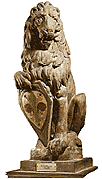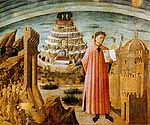
The Marzocco by Donatello
 Part Two
Part Two
Excusez nous mais cette page n'est pas été encore
traduite en Français
Florence was a free Commune from 1075 c. onwards thanks to Matilde di
Canossa, marchioness of Tuscany, and experienced various forms of government; in
1138 it was governed by Four Consuls, who were to become twelve by the
end of the century (two for every sixth part within the city walls, built
in 1172), supported by a Council of one hundred "Buonuomini" (Good
men) and an Assembly or Parliament, composed of all the men in the city
capable of bearing arms. The first Podestà dates from 1193 when
members of the Guilds (representing the economic powers that were to
make Florence so rich and famous) were also admitted to the Council.
In the fight for power that exploded in 1215, the Florentines were divided between
the "Ghibelline" party (feudal nobility and powerful merchants) and
the "Guelph" party (an emerging but cultured middle-class, again with
commercial origins). The former was dominant until 1250, when the mythical Government
of the "Old People" or "First People" was set up to oppose
the power of the Podestà, Frederick II of Swabia; the most important
members of this institution were the Old Men and the Captains of the People,
who were supposed to control the Podestà 's actions, together with the
two Councils. These were completed by the Guilds and the Gonfaloniers, who commanded
the various companies that formed the army, military organizations - the so-called "people's
army" - based in the parish churches, which rebelled against the Swabian
Podestà and threw him out.
The victory of the lower-classes (though they were really merchants, traders
and shop-keepers, not the working forces) over the Swabian dictator was celebrated
with the construction of the Palazzo del Popolo (1255), the Bargello of today,
and the minting of the first gold florin in 1252 (24 c., 3,54 gr.).

Gold Florin
The battle of Montaperti in 1260 gave the city back to the Ghibelline
party, though only for seven years. After Frederick II's defeat and the
arrival of Charles of Anjou, a government was formed in Florence composed
of the Priors of the Guilds (which already existed in the time of the
Podestà but now became a real executive council), aided by a Captain
and Defender of the Guilds (similar to the old Captain of the People).
However the real power remained in the hands of the families of the important
citizens (aristocratic merchants and bankers) by means of the seven principal
Guilds.
Florence tried to create a more democratic arrangement when Prior Giano
della Bella, a nobleman who sympathised with the middle-classes, proclaimed
the "Rules of Justice" in 1292-93. The city's new constitution
prohibited the noble families from having public power and created the
figure of the Gonfalonier of Justice, a magistrate elected to direct
the College of the Priors, lead the army and defend the interests of
the lower-classes. Formally at least, with the exclusion of brief periods
marked by the Seignory of Charles of Calabria and Anjou (1325-28) and
the dictatorship of Gualtiero di Brienne, Duke of Athens (1342), this
form of government lasted until the Medici family came to power.
During the struggle of the powerful magnates against the Rules of Justice, the
Guelph faction split up into two parties, the "Blacks"
and the "Whites" (1300). The former supported noble Corso
Donati, the hero of the battle of Campaldino, who with difficulty
concealed his ambition to become the Lord of Florence, while the
latter were followers of powerful but "low class" Vieri
dè
Cerchi. This brought about a real civil war for the conquest of power
and was to have a famous victim, Dante Alighieri, who was exiled
in 1301 for being a follower of the Whites.

Dante by Domenico da Michelino
The triumph of the Blacks was not enough to abolish the Rules of Justice,
which were anyway reformed in 1328-29 to allow noblemen to take part
in the government. The new Florentine constitution was formed of a Captain
of the People, the College of the Twelve Good Men, which helped the Priors
and the Gonfalonier of Justice, and two Councils (that of the Captain
or the People, composed of 300 commoners, and that of the Podestà or
the Commune, composed of 250 commoners and magnates). A committee of
13 authoritative representatives of the government devised a complicated
election system in Florence which, with a few changes, remained in force
for a century and a half.
The most important social clash, known as "revolt of the Ciompi", took
place in 1378: the lower classes wished to take part in the government of the
city after experiencing the regimes of the aristocratic Consuls, the rich Podestàs
and the middle class Captains of the People and the Priors. The employed workers
- the doublet makers, dyers and wool carders, known as the Ciompi - revolted
because they wanted to found their own Guild and have representatives elected
among the rulers of the city. One of their leaders was Salvestro dei Medici,
who, as a result of his military action, was given a democratic patent for his
family, which was never withdrawn, and became extremely popular. Giovanni, the
real founder of the family wealth, and his son Cosimo
"the Elder" managed several times to obtain positions of
power or were able to control the situation through their allies;
as a result, the city gradually went back to being governed by a
Seignory in spite of still apparently keeping to its ancient Republican
system.

